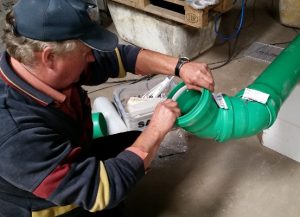The IP-plus welding ring is designed so simply that it can be installed professionally in just a few steps. Replace the existing rubber sealing ring with the IP-plus welding ring and then weld it with an electric welder.
For assembly, the rubber sealing ring is removed from the groove of the pipe system.
As preparation, only the socket area and the spigot end are cleaned with a PP cleaner. Mechanical processing such as peeling or scraping off the oxide layer is completely unnecessary here! Insertion forces during assembly of the pipeline do not occur. This enables extremely convenient installation even in confined spaces.
After the IP-plus welding ring has been inserted, the pipe is pushed together as usual. The subsequent welding now joins all components together in a non-detachable manner.
Welding indicators:
 The IP-plus welding system offers the possibility of external indication. For this purpose, thermo-sensitive indicator stickers are used, which indicate a performed weld by discoloration.
The IP-plus welding system offers the possibility of external indication. For this purpose, thermo-sensitive indicator stickers are used, which indicate a performed weld by discoloration.
From the inside, a completed weld is indicated by a slight bulge. This bead has an elevation of a few 1/10 mm, but is visible due to the acute angle during camera inspection.
Thus, even after the pipeline has been backfilled, a clear statement can be made as to whether welding has been carried out.
Connections to other components
For the transition to other components, the IP-plus welding system offers various options.
All plastic manholes and fittings made of polypropylene with the socket or spigot end designs in accordance with the DIN EN 14758 or DIN EN 1852 standards can be welded on directly and without any problems. Connections to concrete manholes are made using the original manhole chucks of the pipe systems. In any case, please have us check the functionality of the couplers with regard to the IP-plus welding system.
For the transition to PE-HD lines, we recommend the use of flanged connections.







